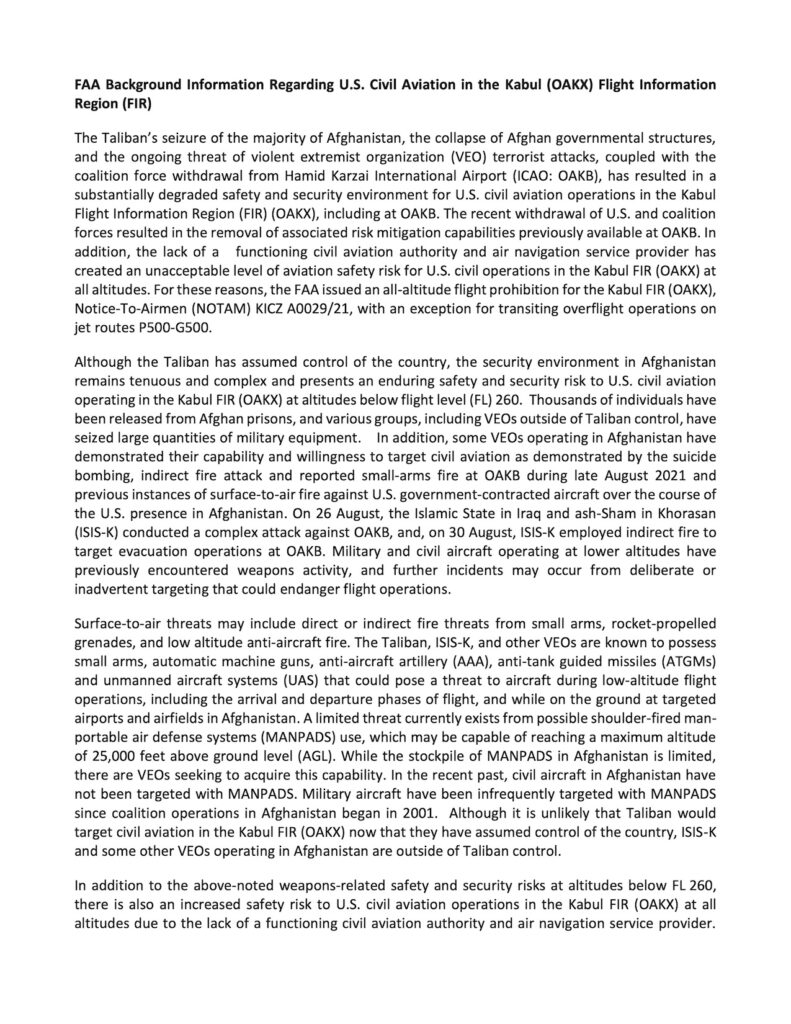The situation in Kabul remains dynamic. An update was issued today regarding ongoing changes within the OAKX/Kabul FIR and at OAKB/Kabul airport.
The full notice issued by ICAO following their most recent video-teleconference is available here.
The ongoing situation
Qatar and Turkey continue to work with the new Afghanistan government to help bring Kabul airport back to operational status, and to restore safe overflights. This includes the repair of damaged radar and other facilities, as well assisting in restructuring the CAA.
Qatar officials are coordinating with the Afghanistan CAA are conducting assessments on capacity and needs. They have apparently deployed a technical team to Kabul to carry out work. The DME has been re-established but notams suggest the VOR remains out of operation.
Turkey maintains a military presence at Kabul airport to assist and is apparently in discussions to help run the airport again – having done so for 6 years previously.
ICAO remain in contact with the Afghanistan Civil Aviation Authority who have provided updates confirming newly appointed members, and a designated point of contact.
Operational updates
- OAKB/Kabul airport and OAMS/Mazar-e-Sharif airport are both reported to now have limited ATS services. There is a limited tower service to support VFR operations at Kabul between 0330-1330 UTC. Mazar-e-Sharif has an FIS available, but the scope of this is unknown.
- A shortage of ATC staff continues to reduce capability.
- Pakistan is assisting Afghanistan in the restoration of the Afghanistan NOTAM service. The service has been partially restored as of Sep 6, and is available via https://www.afgais.com/
- Out of date Notams remain in the system so caution is advised using the site.
- The Kabul FIR remains effectively closed to overflights – the OAKX/Kabul FIR is uncontrolled.
Updated OAKX Notams
The following Notams are the up-to-date Notams issued by the restored office.
- A0721/21 address contingency procedures and advises that aircraft requiring emergency descent should follow ICAO Doc 4444 procedures, but rather than advising ATS, should broadcast on the relevant TIBA frequency.
- A0720/21 advises flights will encounter delaying action prior to entering the Kabul FIR to ensure 15 minute separation. This is as per Notam A0715/21 which requires all traffic below FL280 to be spaced at 15 minutes prior to the FIR entry point.
- A0719/21 advises that the AIS services including Notam office is now operational 24/7.
- A0718/21 advises that all flight plans must be filed at least 24 hours prior to the flight. The contact email is permissions.acaa@gmail.com.
- A0717/21 advises PSR and SSR are now available at OAKB/Kabul, with an advisory information service only.
- A0716/21 advises that OAKB/Kabul is open for domestic and international flights. Operating hours are 0330-1330 UTC.
Our previous post covering the background to the situation can be read here.
The ICAO presentation from the recent video teleconference is available to view here.
IFALPA have updated their Safety Bulletin
Following the notice issued by ICAO, IFALPA updated their safety bulletin for the OAKX/Kabul FIR.
Here are the key changes:
- Unknown aircraft have been observed on random tracks between FL220 and FL250.
- There is limited ATS at OAKB/Kabul – radar services are advisory only.
- The ILS is working, but should be monitored closely.
- People and vehicles have been seen entering the runway.
- The status of other airports isn’t known.
Germany have changed their warning
EDWW has issued a new Notam B1244/21 valid from Sep 13. German operators are prohibited from entering the OAKX/Kabul FIR, except for overflights above FL330 on airways P500-G500. The only change is the exception of those airways which connect Pomir in Tajikistan to Peshawar for alternate routing from Europe to Pakistan and Asia.

Airway P500/G500 in the OAKX/Kabul FIR remain available.
The US has published some new background info
On Sep 14, the US FAA published a new Background Information note for Afghanistan, following their flight ban issued in August as per KICZ A0029/21.
The primary risk on the ground and at lower altitudes relates to the ongoing threat of weapons activity and terrorist attacks – and following the withdrawal of US and coalition forces there are no longer any risk mitigation capabilities available at OAKB/Kabul airport. Although it is unlikely that Taliban would target civil aviation now that they have assumed control of the country, ISIS and other militant group are still operating in Afghanistan outside of Taliban control.
The primary risk for overflights relates to the lack of ATC service, functioning CAA and air navigation service provider.
Bottom line, US operators are banned from the OAKX/Kabul FIR except for airway P500/G500.
To view all current published airspace warnings for Afghanistan, head to SafeAirspace.net.
More on the topic:
- More: July 2024: Afghanistan Overflight Update
- More: Aug 2023: Who wants to overfly Afghanistan?
- More: The India-Pakistan Conflict: Impact on Flight Operations
- More: Afghanistan: Do Not Fly
- More: FAA issues Emergency Order for Afghanistan (Updated)
More reading:
- Latest: LOA Guide for US Operators
- Latest: NAT Ops: Flying the Blue Spruce Routes
- Latest: NAT Guide 2025 – My First NAT Flight is Tomorrow
- Safe Airspace: Risk Database
- Weekly Ops Bulletin: Subscribe
- Membership plans: Why join OPSGROUP?












 Get the famous weekly
Get the famous weekly 





